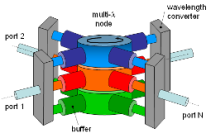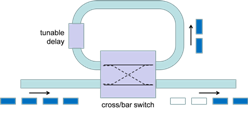Networks
Research themes
Optical networks
| summary |
Optical fibre offers an extra dimension for communication with respect to copper cables, namely the wavelength of light. Thus a fibre-based network node may route incoming packets not only by switching in the time domain, but may also use the wavelength domain for switching. As a consequence, this type of node can be modelled by a so-called multi-server polling model, where the assignment of servers to the various queues involves a graph matching problem.
Unfortunately, in optical networks it is difficult to store photons. Buffering in these networks is typically realised by sending optical packets into fibre delay loops, i.e., letting them recirculate in a fibre loop and extracting them after a certain number of circulations. On top of this integer multiple of a fixed delay time, a small continuously variable delay time may be added (by inserting in the loop a short waveguide with adjustable refractive index). The buffering feature can be modelled by so-called retrial queues.
The goal of this project is to analyze and optimize the performance of optical networks within the physical constraints put by optical fibre technologies. On the one hand, fibre-based network nodes will be simulated in detail; on the other hand, they will be modelled by novel time-slotted polling systems with dynamic assignment of multiple servers and retrials.
|
| Supervisors | Onno Boxma (TU/e), Ton Koonen (TU/e), Jacques Resing (TU/e) |
| PhD Student | Murtaza Ali Abidini |
| Location | Eindhoven University of Technology (TU/e) |



